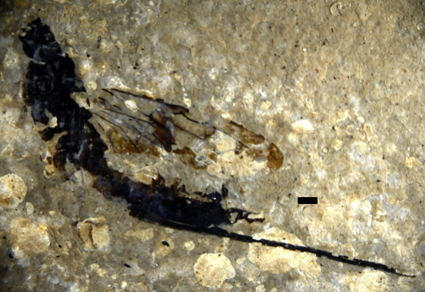Abstract
The new siricid wasp Xeris muratensis sp. nov. is described from the Upper Miocene (ca. 5.60 ± 0.3 Ma) Konservat-Laggerstätte of Sainte-Reine (Cantal, France). Its wing venation characters closely resemble those of the extant Eastern Palaearctic siricid species Xeris malaisei Maa. The new species has a completely black body, vs. presence of yellow spots on head and thorax in X. malaisei. The entomofauna in this lacustrine maar consists of a mixture of extinct species or taxa lacking modern relatives that disappeared during the Pliocene-Pleistocene, and taxa with no discernible difference from their potential extant relatives.
References
- Archibald, S.B., Aase, A. & Nel, A. (2021) The second North American fossil horntail wood-wasp (Hymenoptera: Siricidae), from the early Eocene Green River Formation. Zootaxa, 4999 (4), 325–334. https://doi.org/10.11646/zootaxa.4999.4.2
- Archibald, S.B. & Rasnitsyn, A.P. (2016) New early Eocene Siricomorpha (Hymenoptera: Symphyta: Pamphiliidae, Siricidae, Cephidae) from the Okanagan Highlands, western North America. Canadian Entomologist, 148, 209–228. https://doi.org/10.4039/tce.2015.55
- Archibald, S.B. & Rasnitsyn, A.P. (2022) The early Eocene Eourocerus anguliterreus gen. et sp. nov. (Hymenoptera, Siricidae) from Republic, Washington. Zootaxa, 5105 (2), 289–295. https://doi.org/10.11646/zootaxa.5105.2.8
- Austin, J.J., Andrew, B.S. & Thomas, R.H. (1997) Palaeontology in a molecular world: the search for authentic ancient DNA. Trends in Ecology and Evolution, 12, 303–306. https://doi.org/10.1016/S0169-5347(97)01102-6
- Benson, R.B. (1943) Studies in Siricidae, especially of Europe and Southern Asia (Hymenoptera; Symphyta). Bulletin of Entomological Research, 34, 28–51. https://doi.org/10.1017/S0007485300023464
- Ferguson, D.K. & Knobloch, E. (1998) A fresh look at the rich assemblage from the Pliocene sink-hole of Willershausen, Germany. Review of Palaeobotany and Palynology, 101, 271–286. https://doi.org/10.1016/S0034-6667(97)00078-X
- Goulet, H., Boudreault, C. & Schiff, N.M. (2015) Revision of the world species of Xeris Costa (Hymenoptera: Siricidae). Canadian Journal of Arthropod Identification, 28, 1–127.
- Grimaldi, D.A. & Engel, M.S. (2005) Evolution of the insects. Cambridge University Press, Cambridge, New York and Melbourne, xv + 755 pp.
- Hörnschemeyer, T., Wedmann, S. & Poinar, G. (2010) How long can insect species exist? Evidence from extant and fossil Micromalthus beetles (Insecta: Coleoptera). Zoological Journal of the Linnean Society, 158, 300–311. https://doi.org/10.1111/j.1096-3642.2010.00702.x
- Knobloch, E. (1998) Der Pliozäne Laubwald von Willershausen. Documenta Naturae, 120, 1–302.
- Lepeletier de Saint-Fargeau, A. & Audinet-Serville, J.G. (1828) Encyclopédie Méthodique. Histoire Naturelle. Entomologie, ou Histoire Naturelle des Crustacés, des Arachnides et des Insectes, 10, 345–833.
- Manen, J.F., Savolainen, V., de Marchi, S. & Riou, B. (1995) Chloroplast DNA sequences from a Miocene diatomite deposit in Ardèche (France). Comptes-Rendus de l’Académie des Sciences, Sciences de la Vie, 318, 971–975. [https://api.semanticscholar.org/CorpusID:89457295]
- Manukyan, A.R. & Smirnova, A.V. (2021) New data on the family Siricidae (Hymenoptera, Symphyta) in Baltic amber. Paleontological Journal, 55 (2), 157–165. https://doi.org/10.1134/S003103012102009X
- Moulds, M., Kaulfuss, U. & Gehler, A. (2023) A review of the singing cicada fossils from the Pliocene Fossil-Lagerstätte Willershausen, Germany, with the description of three new species (Hemiptera: Cicadidae: Tibicinae and Cicadinae). Palaeoentomology, 6 (5), 459–471. https://doi.org/10.11646/palaeoentomology.6.5.5
- Nel, A. (1988) Les Sialidae (Megaloptera) fossiles des diatomites de Murat (Cantal, France) et de Bes-Konak (Anatolie, Turquie). Neuroptera International, 5, 39–44.
- Nel, A. (1991) Description et révision de trois “Siricidae” fossiles du Cénozoïque (Hymenoptera, Siricina, Vespina) Bulletin de la Société Entomologique de France, 96 (3), 247–253. https://doi.org/10.3406/bsef.1991.17719
- Nel, A., Arillo, A. & Martínez-Delclòs, X. (1996) New fossil Odonata (Insecta) from the Upper Miocene of France and Spain. (Anisoptera and Zygoptera). Neues Jahrbuch für Geologie und Paläontologie, Abhandlungen, 199, 167–219. https://doi.org/10.3390/insects13020218
- Nel, A., Arillo, A. & Ortuño, V. (1997) New Western Palaearctic Cenozoic Odonata. (Insecta: Odonata: Zygoptera and Anisoptera). Bulletin de la Société Entomologique de France, 102, 265–270. https://doi.org/10.3406/bsef.1997.17342
- Nel, A. & Paicheler, J.-C. (1994) Les Lestoidea (Odonata, Zygoptera) fossiles: un inventaire critique. Annales de Paléontologie, 80, 1–59.
- Nel, A., Sammut, R.M., Wei, M., Niu, G. & Jouault, C. (2022) The first fossil representatives of the sawfly genera Emphytus and Empria from the upper Miocene of France (Hymenoptera, Tenthredinidae). Insects, 13, 218. https://doi.org/10.1371/journal.pone.0239521
- Peris, D., Janssen, K., Barthel, H.J., Bierbaum, G., Delclòs, X., Peñalver, E., Solorzano-Kraemer, M.M., Jordal, B.H. & Rust, J. (2020) DNA from resin-embedded organisms: past, present and future. PLoS ONE, 15 (9), e0239521. https://doi.org/ 10.1371/journal.pone.0239521
- Popov, Yu.A. (2007) A new notion on the heteropterofauna (Insecta: Hemiptera, Heteroptera) from the Pliocene of Willershausen (N Germany). Paläontologische Zeitschrift, 81, 429–439. https://doi.org/10.1007/BF02990254
- Raup, D.M. (1978) Cohort analysis of generic survivorship. Paleobiology, 4, 1–15. [https://www.jstor.org/stable/2400143] https://doi.org/10.1017/S0094837300005649
- Rey, R. (1975) Premières données radiométriques relatives à l’âge du niveau pollinique de Reuver. Comptes-Rendus de l’Académie des Sciences, Series D, 281, 503–505.
- Riou, B. (1988) Les insectes du Miocène supérieur de la Montagne d’Andance (Ardèche), implications paléoclimatiques et paléogéogaphiques. Thèse de l’Ecole Pratique des Hautes Etudes, Chaline J. (directeur), Sciences de la Vie et de la Terre (3éme Section), Laboratoire de Préhistoire et de Paléoécologie du Quaternaire, Dijon, 276 pp.
- Roiron, P. (1991) La macroflore d’âge miocène supérieur des diatomites de Murat (Cantal, France). Implications paléoclimatiques. Palaeontographica, Series B, 223, 169–203.
- Schiff, N.M., Goulet, H., Smith, D.R. & Boudreault, C., Wilson, A.D. & Scheffler, B.E. (2012) Siricidae (Hymenoptera: Symphyta: Siricoidea) of the Western Hemisphere. Canadian Journal of Arthropod Identification, 21, 1–305.
- Wedmann, S., Pouillon, J.-M. & Nel, A. (2014) New Palaeogene horntail wasps (Hymenoptera, Siricidae) and a discussion of their fossil record. Zootaxa, 3869 (1), 33–43. https://doi.org/10.11646/zootaxa.3869.1.3


